CS 3710
Introduction to Cybersecurity
Aaron Bloomfield (aaron@virginia.edu)
@github | ↑ |
Encryption
Introduction
Telnet and tcpdump
- Telnet is the old version of ssh (aka SecureCRT), and sends all data as plaintext
- tcpdump will dump all data sent over a TCP/IP interface
- The next slide shows a tcpdump
- … but without the data in the packets, which has been eliminated from this slide
- It’s easy to show that data, though

Codes versus Ciphers
- Codes change the meaning of words, ciphers encrypt them
- Coded messages:
- “The light is on in the attic”
- Cipher’ed messages:
- wkh txlfn eurzq ira mxpsv ryhu wkh odcb grj
- wecrl teerd soeef eaoca ivden
- Reference
Codes
- One- and two-part codes: contains one or two books that correlate coded words with their plaintext meanings
- One-time code: a pre-arranged word or phrase intended to be used only once, and to convey a message
- “Over all of Spain, the sky is clear” - over the radio, it started the Spanish revolt of 1936
Codes
- Idiot code: any sentence with ‘day’ and ‘night’ means ‘attack’ the location in the sentence
- Plaintext: Attack Gotham.
- Codetext: We walked day and night through the streets but couldn’t find it! Tomorrow we’ll head into Gotham.
- Reference
Security through obscurity
- The use of secrecy to hide the cryptographic system being used
- Contrast this with algorithms such as RSA, which are publically analyzed
- The problems is that somebody will figure out how it works (“many eyes make all bugs shallow” - Linus Torvalds)
- And then, if there is a flaw (due to lack of peer review), the system is vulnerable
- Reference
Block-ciphers vs. stream ciphers
Cipher Taxonomy
Classical ciphers and rotor machines
Caesar Cipher
- Julius Caesar used it to send military messages
- Rome’s enemies were unable to crack it!
- A simple substitution cipher
- Encryption: replace any letter with the letter 3 spots beyond
- Decryption: the same, but go 3 letters back
Caesar Cipher

Caesar Cipher analysis
- Example:
- Plaintext: the quick brown fox jumps over the lazy dog
- Ciphertext: WKH TXLFN EURZQ IRA MXPSV RYHU WKH ODCB GRJ
- Pros:
- Easy to encrypt and decrypt by hand
- Cons:
- Easy to crack by hand
Caesar Cipher analysis
- Cracking
- There are only 26 possibilities!
- Well, 25 really – nobody would encrypt with a key of 0 or 26…
- A program could do this in a matter of microseconds; a person in a matter of minutes
- Example: crack “s psxn iyeb vkmu yp pksdr nscdeblsxq” online here (select ‘bruteforce’)
- There are only 26 possibilities!
- Substitution ciphers can be more complex
- Having a mapping, rather than a rotation
Cracking a substitution cipher
- Cracking a Caesar cipher is trivial
- There are only 26 possibilities
- But what about a more general substitution cipher?
- Letter frequency analysis
- ‘e’ is the most common letter (12.7%)
- ‘z’ is the least common letter (0.1%)
- Reference
- Still very easy to crack
Vigenere cipher
- If a Caesar Cipher is a alphabetic substitution, then a Vigenere cipher is a poly-alphabetic substitution cipher
- The table used is the shown on the next slide
- Suppose the message to encrypt is “attackatdawn”
- And the keyword is “lemon”
Vigenere cipher table

Vigenere cipher
- Cipher algorithm:
- Repeat the keyword until it matches the length of the message
- “attackatdawn” is 12 letters; the new keyword is “lemonlemonle”
- Encrypt the first letter of the message using the first letter of the keyword, etc.
- ‘a’ is encrypted with ‘l’, ‘t’ with ‘e’, etc.
- The encryption is done by finding the row of the message character, and the column of the keyword
- Repeat the keyword until it matches the length of the message
Vigenere cipher
 Encrypt “attackatdawn” with “lemon”
Encrypt “attackatdawn” with “lemon”
Vigenere cipher result
- Plaintext: ATTACKATDAWN
- Key: LEMONLEMONLE
- Ciphertext: LXFOPVEFRNHR
Vigenere cipher analysis
- It’s stronger than a Caesar Cipher
- ‘e’ can be encrypted multiple ways
- The weakness is the repeating key
- If you guess the length of the key (or try all possible lengths), then you can crack it
- Let’s say the key is length 5 (a guess, perhaps)
- Then you simply do 5 interwoven Caesar Cipher cracks
- What if the key is as long as the message?
- Reference
One-time pad (OTP)
- A substitution cipher
- Take a random string that is as long as the plain text you want encrypt
- Use modular arithmetic (or XOR, or Vigenere) to determine the encrypted version
- Plain text: helloworld
- One-time pad: zdxwhtsvtv
- Encrypted: hijiwqhnfz
- Reference
One-time pad (OTP) analysis
- Pros
- Proven to be perfectly secure if:
- the pad is truly random
- the pad is only used once
- the pad is kept secret
- This, it is the ONLY cryptosystem with perfect secrecy
- It can be performed by hand
- Proven to be perfectly secure if:
One-time pad (OTP) analysis
- Cons:
- Good for short messages; it’s hard to transport large pads (i.e. network communication)
- Does not provide message authentication
- How do you get the pad to the recipient?
Re-using a one-time pad
| Use an OTP: |
 ⊕ ⊕ 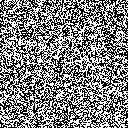 = = 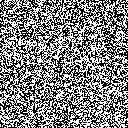
|
|
Re-use the same OTP: |
 ⊕ ⊕  = = 
|
|
Extract the images: |
 ⊕ ⊕  = = 
|
This example from StackExchange
Route cipher
- A transposition cipher
- The plain text is written in a grid
- The secret is the direction to read the cipher text
- Plain text: ‘we are discovered flee at once’
- Cipher progression:
- Key: “spiral inwards, clockwise, starting from the top right”
- Cipher text: REDFLEEAWEJXECNOTEVOCSIDERA
- Reference
Rail fence cipher
- A transposition cipher
- The plain text is written up and down on successive ‘rails’ of a fence
- The encrypted text is then read off in rows
- Plain text: ‘we are discovered flee at once’
- Cipher progression:
W . . . E . . . C . . . R . . . L . . . T . . . E
. E . R . D . S . O . E . E . F . E . A . O . C .
. . A . . . I . . . V . . . D . . . E . . . N . .- Cipher text: WECRL TEERD SOEEF EAOCA IVDEN
- Reference
WW2 Navajo Code Talkers
- Used during the American strategy of island-hopping in the Pacific during WW2
- Native Navajo speakers (which were only in the US!) were used to send messages back and forth over radio frequencies that could be spied on
- The ‘encryption’ or cipher was the language
- There were no written documents or dictionaries in existence
- Other than Navajo Native Americans (all in the US, obviously), there were only 30 or so people who were fluent
WW2 Navajo Code Talkers
- But there was a code as well
- Navajo words were translated into their English equivalents
- The first letter of each English translated word was combined to form the message
- If you didn’t know this, it would be a series of unconnected Navajo words
- It has been stated that the US would not have won the Battle of Iwo Jima without the Navajo code talkers
- References 1 and 2
Rotor machines
- It performs a simple substitution of letters
- After encrypting each letter, the rotors advance positions
- Thus, they implement a poly-alphabetic substitution cipher
- Similar to the Vigenere cipher
- Reference
Rotor machines

Enigma machine
- Most famous rotor machine
- Used by many governments in WW2, especially Nazi Germany
- The Allies were able to decrypt Nazi messages
- But not through crypto-graphically cracking the code!
- This is estimated to have shortened the war in the European theater by 2 years
- Reference
Enigma machine
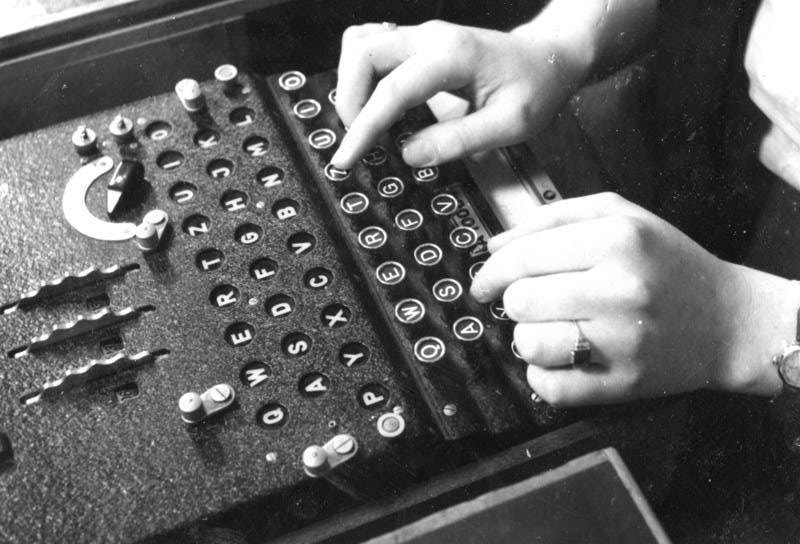
Private key “symmetric” ciphers
Data Encryption Standard (DES)
- Adopted in 1976, it’s a private-key encryption/decryption block cipher
- Briefly, it does a lot of (invertible) bit-shifting in rounds to encrypt/decrypt a message
- How to crack?
- It is susceptible to brute force attacks (\(2^{56} = 7 * 10^{16}\) keys)
- Solution: use DES three times => “Triple DES”
- Use a 56*3 = 168 bit key, and encrypt the message three times, once with each key
Cracking Triple DES encryption
- Brute-force attacks:
- \(2^{168}\) keys, but due to various mathematical properties, this ends up being \(2^{112}\) different keys
- “The best attack known on 3-key TDES requires around \(2^{32}\) known plaintexts, \(2^{113}\) steps, \(2^{90}\) single DES encryptions, and \(2^{88}\) memory”
- NIST (National Institute of Standards and Technology) considers it secure through 2030
DES conspiracy theories
- NSA was involved with DES’ creation
- They convinced IBM to lower the key length from 128 to 64, and then to 56
- And kept many of the details secret
- Many well-respected people criticized the NSA for “improper interference” with the algorithm
- In 1977, Diffie and Hellman (major names in cryptography) proposed a $20 million machine that could crack a DES message in a single day
- It’s known that the NSA had the budget for such a machine. But did they build it?
Advanced Encryption Standard (AES)
- The successor to DES
- Has three possible key lengths: 128, 192, and 256
- NSA approved this standard, and kept the process open
- Like DES, it’s a series of (invertible) bit-shifting in rounds to encrypt/decrypt a message
- Many worry about the security of the standard
- … that somebody may figure a way to crack it mathematically, in particular
- Reference
AES Overview
- Determine number of rounds, \(r\):
- 10, 12, or 14 rounds for 128-bit, 192-bit, and 256-bit keys
- KeyExpansion: derive round keys from Key Round Schedule
- Round 1: AddRoundKey: XOR with round key
- Rounds 2 through \(r-1\):
- SubBytes, ShiftRows, MixColumns, AddRoundKey
- Final round \(r\):
- SubBytes, ShiftRows, AddRoundKey
Key Round Schedule
- Let:
- \(N\): key length in 32-bit words (4, 6, or 8)
- \(K_0, K_1, \ldots K_{N-1}\): 32-bit words of the key
RotWordis a left rotation by 1SubWordis a lookup- \(R_{con}\) is a fixed round constant
- Then repeat the image many times
- It’s fixed for that one key, so only has to be computed once
AES: SubBytes step
- Input is mapped to its mult. inverse in a finite field
- Bytes are replaced based on a fixed substitution table
- Fixed for all of AES
- Called the Rijndael S-box
AES: ShiftRows step
- Rows are shifted cyclically to the left
- This provides diffusion
AES: MixColumns step
- The values are transformed according to the following matrix operation
- This also provides diffusion
\(\begin{bmatrix} b_{0,j} \\\ b_{1,j} \\\ b_{2,j} \\\ b_{3,j} \end{bmatrix} = \begin{bmatrix} 2&3&1&1 \\\ 1&2&3&1 \\\ 1&1&2&3 \\\ 3&1&1&2 \end{bmatrix} \begin{bmatrix} a_{0,j} \\\ a_{1,j} \\\ a_{2,j} \\\ a_{3,j} \end{bmatrix} \text{ for }0 \le j \le 3\)
AES: AddRoundKey step
- Derive a subkey from the main key via the AES key schedule
- Subkey is then XOR’ed with the state
AES Overview
- Determine number of rounds, \(r\):
- 10, 12, or 14 rounds for 128-bit, 192-bit, and 256-bit keys
- KeyExpansion: derive round keys from the AES Key Round Schedule
- Round 1: AddRoundKey: XOR with round key
- Rounds 2 through \(r-1\):
- SubBytes, ShiftRows, MixColumns, AddRoundKey
- Final round \(r\):
- SubBytes, ShiftRows, AddRoundKey
Number Theory
Is that number prime?
- Use the Fermat primality test
- Given:
- \(n\): the number to test for primality
- \(k\): the number of times to test (the certainty)
- The algorithm is:
Is that number prime?
- The algorithm is:
repeat k times:
pick a random number in the range [1, n-1]
if a^{n-1} mod n != 1 then return composite
return probably prime- Let \(n = 105\)
- Iteration 1: \(a = 92: 92^{104} \text{ mod }105 = 1\)
- Iteration 2: \(a = 84: 84^{104} \text{ mod }105 = 21\)
- Therefore, 105 is composite
Is that number prime?
- The algorithm is:
repeat k times:
pick a random number in the range [1, n-1]
if a^{n-1} mod n != 1 then return composite
return probably prime- Let \(n = 101\)
- Iteration 1: \(a = 55: 55^{100} \text{ mod } 101 = 1\)
- Iteration 2: \(a = 60: 60^{100} \text{ mod } 101 = 1\)
- Iteration 3: \(a = 14: 14^{100} \text{ mod } 101 = 1\)
- Iteration 4: \(a = 73: 73^{100} \text{ mod } 101 = 1\)
- At this point, 101 has a \((1/2)^4 = 1/16\) chance of still being composite
More on the Fermat primality test
- Each iteration halves the probability that the number is a composite
- Probability = \((1/2)^k\)
- If \(k = 100\), the probability it’s a composite is \((1/2)^{100} = 1\text{ in }1.2 * 10^{30}\) that the number is composite
- Greater chance of having a hardware error!
- Thus, \(k = 100\) is a good value
More on the Fermat primality test
- Even with a certainty of \(k=100\), it is not certain that the number is prime!
- There are known numbers that are composite but will always report prime by this test
- The Carmichael numbers: 561, 1105, 1729, …
- Reference
Why does this work?
- Fermat’s little theorem: \(a^p-a \mod p=0\), but only if \(p\) is prime
- Equivalent phrasing: \(a^p \equiv a (\text{mod } p)\)
- Equivalent phrasing: \(a^{p-1} \equiv 1 (\text{mod } p)\)
- If \(p\) is not prime, then that equality will not hold if \(a\) and \(p\) share factors
- Consider \(a=2\) and \(p=6\)
- \(2^{6-1} \equiv 1 (\text{mod } p)\) yields \(32 \equiv 1 (\text{mod } p)\), but \(32 \text{ mod } 6=2\)
- Consider \(a=2\) and \(p=6\)
- But how and why does Fermat’s little theorem work?
- There is an entire Wikipedia page on the proofs of it
Google’s recruitment campaign

How to compute \(a^e\text{ mod }n\) ?
- We can’t compute \(a^e\) directly
- If they are 1200 digit numbers, then \(a^e\) will be well over a million digits
- Regardless of the memory usage, that will take quite some time to compute
- Answer: we compute it in steps, and take the mod after each step
- This keeps the overall value down (below \(n\)) since we are mod’ing each time
Compute \(a^{1652} \text{ mod } n\)
- Note \(1652 = 2^{10} + 2^9 + 2^6 + 2^5 + 2^4 + 2^2\)
- Parts:
- Compute \(a^2 \text{ mod } n\), which is one multiplication (\(a \cdot a\)) and one modulus
- Compute \(a^4 \text{ mod } n\), which is a mult (of \(a^2 \cdot a^2\)) and a mod
- Compute \(a^8 \text{ mod } n\), which is a mult and a mod
- …
- Compute \(a^{1024} \text{ mod } n\), which is a mult (of \(a^{512} \cdot a^{512}\)) and a mod
Compute \(a^{1652} \text{ mod } n\)
- Then \(a^{1652} = a^{1024} \cdot a^{512} \cdot a^{64} \cdot a^{32} \cdot a^{16} \cdot a^{4}\)
- This will require:
- 10 multiplications and 10 mods to list of the powers
- Up to 10 more to compute the final product
- The result is \(\log_2(e)\) operations where \(e\) is the exponent
- With 1200 digit numbers, that’s about 4,000 steps
- Memory usage is (relatively) minimal, as we keep mod’ing each time
Running the Fermat primality test
- We can now compute \(a^e \text{ mod } n\)
- To run the test, we repeat:
- Pick a random (odd) number of the correct bit size
- Is it prime as per the Fermat primality test?
- If prime, break
- If not prime, then continue
- We will see Java and Python code to do all this in a moment…
Primarily test conclusions
- If it says “composite” just once, it’s definitely composite
- Otherwise, it just says “probably prime”
- Takes polynomial time (it’s “easy” to compute)
- We use \(k=100\), as a hardware error is more likely beyond that
- The computation involved is \(a^{n-1}\text{ mod }n \neq 1\)
- For 1200 digit numbers (what is used in practice), this is a significant computation!
- We will use existing libraries to compute this
Bit size
- A 100 bit integer is about 30 decimal digits
- You divide the number of bits by \(\log_2(x) / \log_d (x) \approx 3.32\)
- Here, \(\log_d(x)\) is log base 10
- Thus, a 32 bit integer is about 9.6 digits (4 billion is just over 9 digits)
- A 2048-bit number is 616 decimal digits
- A typical length for an RSA key
- A 4096-bit number is 1,233 decimal digits
- A very secure RSA key
- These are the sizes of numbers we are dealing with…
The prime number theorem
- The number of prime numbers less than \(x\) is approximately \(x/\text{ln}(x)\) (reference)
- Rephrased: the chance of a number \(x\) being a prime number is roughly \(1 / \text{ln}(x)\)
- Consider 200 digit prime numbers
- \(\text{ln} (10^{200}) \approx 460\)
- The chance of a random 200 digit number being prime is thus 1/460
- For only odd numbers, the chance is 2/460 = 1/230
- For a 2048 bit odd number (616 decimal digits) it’s about 1/710
RSA
Private key cryptography
- The function and/or key to encrypt/decrypt is a secret
- (Hopefully) only known to the sender and recipient
- The same key encrypts and decrypts
- How do you get the key to the recipient?
Public key cryptography
- Everybody has a key that encrypts and a separate key that decrypts
- They are not interchangable!
- The encryption key is made public
- The decryption key is kept private
Public key cryptography goals
- Key generation should be relatively easy
- Encryption should be easy (polynomial time)
- Decryption should be easy (polynomial time)
- With the right key!
- Cracking should be very hard (exponential time)
RSA
- Stands for the inventors: Ron Rivest, Adi Shamir and Len Adleman
- Three parts:
- Key generation
- Encrypting a message
- Decrypting a message
Key generation steps
- Choose two random large prime numbers \(p\) and \(q\) such that \(p \neq q\), and then compute \(n = p*q\)
- Choose an integer \(1 < e < n\) which is relatively prime to \((p-1)(q-1)\)
- Compute \(d\) such that:
- \(d * e \equiv 1 (mod (p-1)(q-1))\)
- Rephrased: \(d*e \text{ mod }(p-1)(q-1) = 1\)
- Destroy all records of \(p\) and \(q\)
Key generation, step 1
- Choose two random large prime numbers \(p \neq q\)
- In reality, 2048 bit numbers are recommended
- That’s about 617 decimal digits
- Chance of a random odd 2048 bit number being prime is about 1/710
- We can compute if a number is prime relatively quickly via the Fermat primality test
- In reality, 2048 bit numbers are recommended
- We choose \(p = 107\) and \(q = 97\)
- Compute \(n = p*q\)
- \(n = 10379\)
Key generation, step 1
- Java code to find a big prime number:
- Yes, it’s that easy
- That constructor runs the Fermat primality theorem
- And handles the \(a^e \text{ mod } n\) computations necessary
- Python code: see two slides down
Key generation, step 1
- Full Java class to find a big prime number:
import java.math.*;
import java.util.*;
public class BigPrime {
static int numDigits = 617;
static int certainty = 100;
static final double LOG_2 = Math.log(10)/Math.log(2);
static int numBits = (int) (numDigits * LOG_2);
public static void main (String args[]) {
Random random = new Random();
BigInteger prime = new BigInteger (numBits,
certainty, random);
System.out.println (prime);
}
}Key generation, step 1
- Full Python code to find a big prime number:
def fermat_test(n, k):
# adapted from https://gist.github.com/Ayrx/5884802
for i in range(k):
a = random.randint(1, n-1)
if pow(a, n-1, n) != 1:
return False
return True- Usage:
Key generation, step 1
- How long does this take?
- On a modern (3.4 Ghz) machine, the Java version took between 1/2 and 3 seconds
- Different runs require a different number of random number generations
- And this is Java – it would be faster in C or C++
- On a modern (3.4 Ghz) machine, the Java version took between 1/2 and 3 seconds
Key generation, step 1
- Practical considerations
- \(p\) and \(q\) should not be too close together
- \((p-1)\) and \((q-1)\) should not have small prime factors
- Use a good random number generator
Key generation, step 2
- Choose an integer \(1 < e < n\) which is relatively prime to \((p-1)(q-1)\)
- There are algorithms to do this efficiently…
- … but we aren’t going to go over them in this course
- One easy way to do this: make \(e\) be a prime number
- It only has to be relatively prime to \((p-1)(q-1)\), but it can be fully prime
- \(e\) should be a bit smaller than \(n\) (maybe by a factor of 10 or 100 or so)
Key generation, step 2
- Recall that \(p = 107\) and \(q = 97\)
- \((p-1)(q-1) = 106 \ast 96 = 10176\)
- \(10176 = 2^6 \ast 3 \ast 53\)
- We choose \(e = 85\)
- \(85 = 5*17\)
- \(\text{gcd}(85, 10176) = 1\)
- Thus, 85 and 10176 are relatively prime
- Even though 85 is compisite
Key generation, step 3
- Compute d such that:
- \(d \ast e \equiv 1 (\text{mod } (p-1)(q-1))\)
- Rephrased: \(d \ast e \text{ mod } (p-1)(q-1) = 1\)
- There are algorithms to do this efficiently…
- … but we aren’t going to go over them
- We determine \(d = 4669\)
- \(4669 \ast 85 \text{ mod } 10176 = 1\)
Key generation, step 3
- Java code to find d:
import java.math.*;
public class FindD {
public static void main (String args[]) {
BigInteger pq = new BigInteger("10176");
BigInteger e = new BigInteger ("85");
System.out.println (e.modInverse(pq));
}
}- Result: 4669
- Python code to find d:
Key generation, step 4
- Destroy all records of \(p\) and \(q\)
- If we know \(p\) and \(q\), then we can compute the private encryption key from the public decryption key via:
- \(d * e \equiv 1 (\text{mod }(p-1)(q-1))\)
The keys
- We have \(n = p*q = 10379\), \(e = 85\), and \(d = 4669\)
- The public key is \((n,e) = (10379, 85)\)
- The private key is \((n,d) = (10379, 4669)\)
- Thus, \(n\) is not private; only \(d\) is private
- In reality, \(p\) and \(q\) are 616 (or so) digit numbers
- As that is 2048 bits
- Thus \(n\) is a 1200 (or so) digit number
- \(d\) and \(e\) are about 1,199 (or so) digit numbers
Encrypting messages
- To encode a message:
- Encode the message \(m\) into a number
- Split the number into smaller numbers \(m < n\)
- Use the formula \(c = m^e \text{ mod }n\)
- \(c\) is the ciphertext, and \(m\) is the message
- Java code to do the last step:
- Where the object \(m\) is the BigInteger to encrypt
- Python code to do the last step:
- Don’t use
m ** e % nin Python, as it’s too slow
Encrypting RSA messages
Formula is \(c = m^e\text{ mod }n\) 
Encrypting messages example
- Encode the message into a number
- String is “Go Cavaliers!!”
- Modified ASCII codes:
- 41 81 02 37 67 88 67 78 75 71 84 85 03 03
- Split the number into numbers \(< n\)
- Recall that \(n = 10379\)
- 4181 0237 6788 6778 7571 8485 0303
About the modified ASCII codes
- I modify the ASCII codes for this example
- By subracting 30 from each value
- This is just so this example in the slides can use smaller values for \(p\) and \(q\)
- You should NOT be using modified ASCII codes in the RSA homework!
Encrypting messages example
- Use the formula \(c = m^e \text{ mod }n\)
- \(4181^{85}\text{ mod }10379 = 4501\)
- \(0237^{85}\text{ mod }10379 = 2867\)
- \(6788^{85}\text{ mod }10379 = 4894\)
- Etc…
- Encrypted message:
- 4501 2867 4894 0361 3630 4496 6720
Decrypting messages
- Use the formula \(m = c^d\text{ mod }n\) on each number
- Split the number into individual ASCII character numbers
- Decode the message into a string
Decrypting messages example
- Encrypted message:
- 4501 2867 4894 0361 3630 4496 6720
- Use the formula \(m = c^d\text{ mod }n\) on each number
- \(4501^{4669}\text{ mod }10379 = 4181\)
- \(2867^{4669}\text{ mod }10379 = 0237\)
- \(4894^{4669}\text{ mod }10379 = 6788\)
- Etc…
Decrypting messages example
- Split the numbers into individual characters
- 41 81 02 37 67 88 67 78 75 71 84 85 03 03
- Decode the message into a string
- Modified ASCII codes:
- 41 81 02 37 67 88 67 78 75 71 84 85 03 03
- Retrieved String is “Go Cavaliers!!”
- Modified ASCII codes:
modPow computation
- How to compute \(c = m^e\text{ mod }n\) or \(m = c^d\text{ mod }n\)?
- Example: \(4501^{4669}\text{ mod }10379 = 4181\)
- Computation means:
- Java: use the
BigInteger.modPow()method - Perl: use the
bmodpow()function in the BigInt library - C++: Use the
bigintclass (http://sourceforge.net/projects/cpp-bigint/) - Python: use the 3-parameter version of
pow() - Etc…
- Java: use the
Why does this work?
- The values of \(d=4669\) and \(e=85\) are the inverse of each other for exponentiation within \(n=10379\)
- \((x^e)^d \text{ mod } n == x\)
Cracking a message
- In order to decrypt a m, we must compute \(m = c^d \text{ mod }n\)
- \(n\) is known (part of the public key)
- \(c\) is known (the ciphertext)
- \(e\) is known (the encryption key)
Cracking a message
- Thus, we must compute \(d\) with no other information
- Recall: \(n = p \ast q\)
- Recall: choose an integer \(1 < e < n\) which is relatively prime to \((p-1)(q-1)\)
- Recall: Compute \(d\) such that: \(d \ast e\text{ mod }(p-1)(q-1) = 1\)
- Thus, given \(n\) and \(e\), we have to compute \(d\)
Cracking a message
- Thus, we must factor the composite \(n\) into its component primes
- There is no efficient way to do this!
- We can, very easily, tell that \(n\) is composite, but we can’t tell what its factors are
- Once \(n\) is factored into \(p\) and \(q\), we compute \(d\) as above
- Then we can decrypt \(c\) to obtain \(m\)
Cracking a message example
- In order to decrypt a message, we must compute \(m = c^d\text{ mod }n\)
- \(n = 10379\), \(e = 85\), and \(c\) is the ciphertext
- In order to determine \(d\), we need to factor \(n\)
- \(d \ast e\text{ mod }(p-1)(q-1) = 1\)
- We factor \(n\) into \(p\) and \(q\): 97 and 107
- This would not have been feasible with two large prime factors!!!
- \(d \ast 85 (\text{mod }(96)(106)) = 1\)
- We then compute d as above, and crack the message
Why RSA is considered secure
- RSA security is based on two principles:
- First: factoring large composites into their prime factors is hard
- In 2005, a 193-digit number was factored using 12.5 CPU years on a 2.2 GHz Operon CPU (actually 5 months on 30 CPUs)
- The best algorithm for factoring large numbers (general number field sieve) is \(O(e^n)\)
Why RSA is considered secure
- RSA security is based on two principles:
- Second: the “RSA problem”: finding the \(e^{th}\) roots modulo a composite number \(N\) is hard
- Specifically, given \(c = m^e\text{ mod } n\), and knowing \(c\), \(e\), and \(n\), finding \(p\) is hard
- Considered as hard as integer factorization
Current factoring state of the art
- “As of the end of 2007, thanks to the constant decline in memory prices, the ready availability of multi-core 64-bit computers, and the availability of [efficient factoring software], special-form numbers of up to 750 bits and general-form numbers of up to about 520 bits can be factored […]. These bounds would increase to about 900 and 600 [on a] few dozen PCs”
- We used 2048 bit (617 decimal digit) numbers!
- http://en.wikipedia.org/wiki/Integer_factorization_records
Signing a message
- Recall that we computed:
- \(d*e\text{ mod }(p-1)(q-1) = 1\)
- Note that \(d\) and \(e\) are interchangeable!
- You can use either for the encryption key
- You can encrypt with either key!
- Thus, you must use the other key to decrypt
Signing a message
- To “sign” a message:
- Write a message, and determine the SHA-256 (or similar) hash
- Encrypt the hash with your private (encryption) key
- Anybody can verify that you created the message because ONLY the public (encryption) key can decrypt the hash
- The hash is then verified against the message
Signing a message
- You are encrypting the HASH of the message
- And doing so with your PRIVATE key
- The message itself is not being encrypted at all
- Anybody can decrypt the encrypted hash by using your public key
- And verify that it matches, as they can compute the hash themselves
Signing a message: detail
- Write out a plaintext message \(m\)
- Take the SHA-256 (or similar) hash of the message \(m\) to get hash value \(h\)
- Encrypt \(h\) with your private key \((n,d)\) to get \(c\)
- This is your private key that is being used for encryption here
- The message you send is \(x = m \cdot c\)
- That’s concatenation
Checking a message signature: detail
- You receive message \(x = m \cdot c\) from somebody with public key \((n,e)\)
- You separate \(x\) into it’s constituent parts \(m\) and \(c\)
- You decrypt \(c\) using public key \((n,e)\) to get \(h_1\)
- That’s the public key being used for decryption here
- You take the SHA-256 (or similar) hash of \(m\) to get \(h_2\)
- If \(h_1\) and \(h_2\) match, then it was signed by the person with the private key that matches public key \((n,e)\)
PGP and GnuPG
- Two applications which implement the RSA algorithm
- PGP was written in 1991 by Phil Zimmerman
- The US government didn’t like PGP…
- Gnu Privacy Guard (GnuPG) is open-source (thus it’s free) implementation of PGP, written in 1999
- Both follow the OpenPGP Message Format
- Specified in RFC 4880
The US gov’t and war munitions

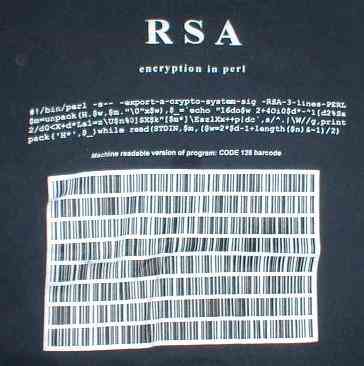
RSA vulnerabilities
- If \(e\) is small, and \(m\) is small (such that \(m^e < n\)), then the ciphertext can be easily decrypted
- If multiple receivers share the same \(e\), but different \(p\), \(q\), and \(n\), then the same clear text message encrypted for the multiple receivers can be cracked via the Chinese remainder thoerem
- RSA is vulnerable to chosen plaintext attacks (where you encrypt likely plain texts and compare it to the cipher text)
- Etc.
Solution
- Pad the message to make it longer
- And add random bits in the padding to prevent multiple encryptions of the same plain text from being the same cipher text
- There are standards for doing this (PKCS#1)
How to “crack” RSA
- Factoring \(n\) is not feasible
- Thus, “cracking” RSA is done by other means
- Intercepting the private key
- “Hacking” into the computer, stealing the computer, etc.
- Man-in-the-middle attack (next few slides)
- Etc.
Security

“Normal” RSA communication 






SSH display to get a key

Man-in-the-middle attack
- An attacker (“Mallory”) intercepts the communications between two participants, and relays messages between them
- Perhaps Mallory has access to a router that the messages pass through
- Obviously, the participants (“Alice” and “Bob”) are unaware that Mallory is relaying the messages
- Specifically, we assume that Mallory can MODIFY the messages being sent
- Not just listen to them
MITM RSA communication 






SSH display with a possible MITM

How to prevent MITM attacks
- You need a way to ensure that the key you get is the correct key
- This gave rise to key stores
- Store in the sense of storage, not selling things
- A key store’s public key was well known and widely published
- When you create a key, you upload it to the key store
- Somebody else would get your key from the key store
- Still possible for me to upload a key and claim it’s yours, though…
Other public key encryption methods
- The goals are the same as RSA
- There must be two keys, which are paired
- Encryption and decryption (with the key!) should be “easy” (i.e. polynomial time)
- Cracking the message should be “hard” (i.e. exponential time)
- Other ideas:
- Discrete logarithms (next slide)
- Elliptic curves (next->next slide)
Discrete logarithms
- Consider a mathematical group, or a congruence class, such as \(Z_{12}\)
- This is the same as a clock: add numbers, and mod the result by 12
- Exponentiation: \(3^4 = 81\)
- But in the \(Z_{17}\), 81 is really 13 as \(81\text{ mod }17 = 13\))
- Thus \(3^4 = 13\) in \(Z_{17}\)
- Or \({\log}_3 13 = 4\)
- Exponentiation is “easy”, but finding a logarithm is “hard”
- Reference
Elliptic curves
- A curve of the form \(y^2=x^3+a\cdot x+b\)
History
- 1976: Whitfield Diffie and Martin Hellman publish “New Directions in Cryptography”, which proposes a public-key (i.e. asymmetric) system
- 1978: RSA is invented by Rivest, Shamir, and Adleman
- 1997: Whoops! It turns out Diffie-Hellman and RSA were invented (independently) a bit earlier
- Diffie-Hellman by a British intelligence service (GCHQ) in ’74
- RSA, also by the same British intelligence service, in 1975
Quantum computers
- A quantum computer could (in principle) factor \(n\) in reasonable time (\(O(b^3)\), where \(b\) is the number of bits)
- This would make RSA obsolete!
- Shown (in principle) by Peter Shor in 1993
- You would need a new (quantum) encryption algorithm to encrypt your messages
- This is like saying, “in principle, you could program a computer to correctly predict the weather”
- I bet the NSA is working on such a computer, also
- In 2022, a 48-bit number was factored using a quantum computer (source: wikipedia)
- Modern RSA has \(n\) with 4,096 or 8,192 bits
Quantum computing factorization
- In 2012, UCSB built a quantum computer that can factor 15 into 3*5 with 48% accuracy
- Yes, really
- (Okay, I realize that it was a big advancement, but come on now…)
- And it cost a lot of money…
- reference
Latest quantum computing stats
- April 2012: 143 factored into 13*11
- April 2016: factored 200,099 into 401*499
- reference
Should we be worried?
- Probably not just yet
- It will likely be a while before quantum computers can be used to factor numbers used in modern encryption
- And, at that point, we’ll just use quantum encryption
- See here for more details…
Randomness
Random Number

Computers and randomness
- A computer, by definition, produces the same output for the same input
- So how, then, can it produce truly random numbers?
- The answer: it can’t
- We instead generate pseudo-random numbers
- Pseudorandomness: “A pseudorandom process is a process that appears to be random but is not”
- That’s all a computer can really generate
Necessity of randomness
- Much of encryption depends on randomness
- If you could “guess” the random number sequence, then you could figure out the one-time pad
- … or the generated ssh keys, or the RSA keys…
- So we need really good random numbers
- Formally, we need a cryptographically secure pseudorandom number generator
- Formal definition shortly, but basically, it produces pseudo-random numbers that appear truly random
Typical generation method
- The linear congruential generator (LCG)
- \(X_{n+1}=(a*X_n+c) \text{ mod } m\)
- \(m\) is the modulus, and must be positive
- \(a\) is the multiplier: \(0 < a < m\)
- \(c\) is the increment: \(0 < c < m\)
- \(X_0\) is the seed value
- This will cycle through all values less than \(m\) iff:
- \(m\) and \(c\) are relatively prime (i.e, \(\gcd(m,c)=1\))
- \(a-1\) is divisible by all prime factors of \(m\)
- \(a-1\) is divisible by 4 if \(m\) is divisible by 4
Typical method: example
- Let \(m=9\), \(a=4\), \(c=7\)
- We’ll arbitrarily decide to start the sequence at 1
- Thus, \(X_0=1\)
- Will this cycle through all values less than \(m\)?
- \(m\) and \(c\) are relatively prime: yes, as \(\gcd(9,7)=1\)
- \(a-1\) is divisible by all prime factors of \(m\): yes, the factors of 9 (3, 3) also divide 3 (which is \(a-1\))
- \(a-1\) is divisible by 4 if \(m\) is divisible by 4: not applicable, as 3 (which is \(a-1\)) is not divisible by 4
Typical method: example
- Let \(m=9\), \(a=4\), \(c=7\)
- This will cycle through all the values, as shown on the last slide
- \(X_{n+1}=(a*X_n+c) \text{ mod } m\)
- \(X_0 = 1\)
- \(X_1 = (4*1+7) \text{ mod } 9 = 2\)
- \(X_2 = (4*2+7) \text{ mod } 9 = 6\)
- \(X_2 = (4*6+7) \text{ mod } 9 = 4\)
- \(X_3 = (4*4+7) \text{ mod } 9 = 5\)
- Rest of the sequence: 0, 7, 8, 3, and then back to 1
Typical method: example
- The linear congruential generator (LCG) sequence with \(m=9\), \(a=4\), \(c=7\):
- 1, 2, 6, 4, 5, 0, 7, 8, 3, and then back to 1
- But where to start in the sequence?
- We could start anywhere therein
- Where we start is called the seed
- Different seed values just start at a different spot in the cycle of random numbers
LCG parameters in use
- libc uses \(a=1103515245\), \(c=12345\), and \(m=2^{31}\)
- This is what is called by
rand()in C and C++; setting the seed is done bysrand() - This will cycle through 2 billion (\(2^{31}\)) values before repeating
- This is what is called by
- It will cycle through all the values, as per the three properties defined earlier
- With a seed of 1, the initial sequence is:
- 1, 1103527590, 377401575, 662824084, 1147902781, 2035015474, 368800899, …
LCG parameters in use
- RANDU used \(a=65539\), \(c=0\), and \(m=2^{31}\)
- Used from the 1960’s, it created a very easy to calculate sequence on old hardware
- See Why RANDU is a bad random number generator
- It does NOT cycle through all possible numbers
- \(\gcd(2^{31},0)\neq 1\), as \(\gcd(a,0)=a\)
- \(a-1=65538\) is not divisible by 4 whereas \(m=2^{31}\) is
- With a seed of 1, the initial sequence is:
- 1, 65539, 393225, 1769499, 7077969, 26542323, …
- All odd numbers!
LCG parameters in use
- See here for more possibilities
What seed to use?
- If you use the same seed, you will always get the same random sequence
- Many people use
time(NULL)in C/C++- This is the current number of seconds since January 1st, 1970
- Which is how UNIX systems keep track of time
- But if you run the program twice in the same second, it will use the same sequence!
- That being said, this is probably sufficient for non-cryptographic purposes
- You could use the current time in milliseconds…
More randomness
- There are many and better pseudo-random number generators
- Those that are computationally indistinguishable from true random numbers are considered suitable for cryptography
- These is what defines a cryptographically secure pseudorandom number generator
- But how to get the initial seed?
- Especially when computers produce the same output on the same input?
More randomness
- We need a randomness extractor:
“a function, which being applied to output from a weakly random entropy source, together with a short, uniformly random seed, generates a highly random output that appears independent from the source and uniformly distributed”
More randomness
- So how to get that “weakly random entropy source”?
- You could use other input values such as:
- The 10th and 11th bit of the floating point value read in from the CPU temperature sensor
- Or the hash of that entire temperature value (use a good hash, as described later in this slide set)
- Or any other sensor that the computer has available
- Or many other methods
Cloudflare uses a wall of lava lamps (source)

Determining randomness
- To tell if a number sequence is truly (pseudo-) random, you run randomness tests on it
- Examples:
- Run it a bagillion times and see if the distributions of the numbers is uniform across the range
- See if the numbers follow a normal distribution (when run through the correct formulas)
- Interpret the numbers as 5 card stud poker hands, and see if the distrubtion of hands is the expected distribution
- And many others…
Debian OpenSSL predictability
- A bit of background first…
- Open source software is maintained by certain individuals
- Here called the “upstream developers”
- Different Linux distrubtions will package them for easy installation
- Example:
sudo apt-get install openssl - Volunteers, called “package maintainers” do this work
- They are typically not the upstream developers
- Example:
Debian OpenSSL predictability
- Package maintainers do the following:
- Compile the (upstream) source code for various hardware platforms
- Change the configuration to match the system default (location of config files, etc.)
- Specifying the necessary dependent libraries / packages
- Putting all this together into an installable package, and uploading that to the distribution’s servers
Debian OpenSSL predictability
- In 2007 or 2008, the package maintainer for OpenSSL (the primary cryptographic library) noticed a series of warnings the compiler generated, and tracked them down to a given line in the code
- Not being familiar with the code, he asked the upstream developer if that line could be removed
- The upstream developer said “yes”
- The line was removed, and the package distributed
Debian OpenSSL predictability
- But that line is what added the randomness!
- Without it, there were only 65k possible SSH keys that could be generated!
- Any computer could generate all of them in less than a day
- Once patched, everybody had to regenerate their ssh keys…
- Read more here
Security Holes

Dependency

Hashing
Ensuring the download is correct…
- What if we don’t want to encrypt the data?
- So anybody can download it: patches, open source code, etc.
- But we want to be sure to allow those people to verify that they downloaded the correct file
- And that they didn’t have any download errors
- Solution: provide a hash code of the file
Hashing properties
- Hash goals:
- Changing even a single bit has a dramatic effect on the hash code
- Pigeon hole principle:
- If we use a 128-bit hash, that yields \(2^{128} \approx 3.4 * 10^{38}\) possible values
- If we have files that are 129+ bits, then there will be more possible files than there are hashes
- Thus, multiple files will provide the same hash
- This will hold for all hashes, as long as the hash code is of a finite length
Hash vulnerabilities
- For a hash function to be really vulnerable, we want to be able to take an arbitrary text and make it match the desired hash code
- Sender sends: “deposit $1 million into account 12345” with hash “abcdefg”
- You intercept and send a new message: “deposit $1 million into account 67890; (fl_0” with hash “abcdefg”
- The trailing “; (fl_0” allowed the different document to match the same hash
Hash vulnerabilities
- Being able to create two “random” files that match the same hash indicates a weakness, but is not yet a vulnerability
Hashes are one-way!
- Consider the following two files:
- (from here, as it may not render properly on the slides)
- The both have the same MD5 hash of 79054025255fb1a26e4bc422aef54eb4
- So given the MD5 hash, how do we know which one it came from?
Pigeonhole principle
- An MD5 hash is 128 bits; SHA hashes go up to 512 bits
- There are more files possibilites of 129 bits (or 513 bits) than there are possible hashes
- Thus, as per the pigeonhole principle, there will be multiple inputs for a given hash
- So how do you know how to go back from a hash?
- Answer: you don’t
Collision resistant hashes
- A collision resistant hash means that it is “hard” to find two inputs that hash to the same value
- Harder than, say, brute force
- If there is any way easier than brute force, that’s bad
Collision resistant hashes
- Due to the birthday paradox, one will typically have to brute force \(2^{n/2}\) attempted values before a collision is found
- For MD5 (128 bits): \(2^{128/2} = 2^{64} = 1.84 * 10^{19}\) attempts
- Computing 1 million a second takes \(5.85 * 10^{11}\) years
- But a better attack can achieve this in under a minute
- (MD5 is not collision resistant, as described later)
- For MD5 (128 bits): \(2^{128/2} = 2^{64} = 1.84 * 10^{19}\) attempts
Collision resistant hashes
- For SHA-256 (256 bits): \(2^{256/2} = 2^{128} = 3.40 * 10^{38}\) attempts
- Computing 1 million a second takes \(1.08 * 10^{31}\) years
- reference
CRC32: Cyclic Redundancy Check
- The hash value is a 32-bit integer
- There are variants of other bits: 16, 64, etc.
- Is used for downloading files (via modem, download program, etc.) – i.e. as a checksum
- It works great for this purpose
- With the (simple) math behind the checksum, and “only” 4 billion possibilities, one can target a specific CRC 32 hash value
- This is a homework problem in the hashing homework
MD5: Message Digest 5
- Produces a 128-bit value (\(3.4 * 10^{38}\) possible values)
- Expressed as a 32-digit hex number
- Was the most widely used algorithm
- Designed in 1991 when research indicated its predecessor (MD4) was insecure
- Printed in hex:
MD5: Message Digest 5
- Still widely used for file downloading
- CERT: “should be considered cryptographically broken and unsuitable for further use”
- A number of collisions have been found:
- 1996: “first” collisions found
- 2005: public keys (with associated private keys) could be constructed that have the same MD5 hash
- 2008: researchers faked SSL certificate validity by creating keys with desired MD5 hashes
- You can create two programs with the same MD5 hash
SHA-0 and SHA-1
- Designed by the NSA
- After the DES debacle, it’s become an open standard
- Published by NIST (National Institute of Standards and Technology)
- 160 bit hash
- SHA-0 (1993): had a flaw, was quickly corrected
- The flaw introduced an unintended weakness
- SHA-1 (1995): fixed that flaw, was very widely used for security applications
- But typically not for downloading files
SHA-0 and SHA-1
- In 2005, security flaws were discovered in SHA-1
- A vulnerability has not been shown, however
- reference
SHA-2
- Designed in 2001 to address the flaw discovered in SHA-1
- There are 4 variants, depending on the length of key desired: SHA-224, SHA-256, SHA-384, SHA-512
- SHA-2 is mathematically similar (but not identical!) to SHA-1 (source code)
- So if there are vulnerabilities in SHA-1, do they exist in SHA-2?
- Nobody knows, but this lead to the development of SHA-3
- Most US gov’t applications require a SHA-2 hash
SHA-3
- Intent is for it NOT to derive (or be similar to) SHA-2
- So if the SHA-1 vulnerability exists in SHA-2, it thus will not affect SHA-3
- NIST (National Institute for Standards and Technology) had an open solicitation / compettion for the algorithm
- The particular one selected was Keccak
Storing passwords
- No (secure) system stores user passwords in plaintext
- Instead it stores a hash of those passwords
- On login, it hashes your attempt, and then compares the hashes
- Thus, there could be multiple passwords that would log you in
- This leads to vulnerabilities…
Dictionary attacks
- To perform a dictionary attack:
- Take every hashed password for a given system
- Take every word in the English language, and hash it
- Find the intersection of those, and you have a bunch of passwords
Rainbow tables
- A rainbow table is a pre-computed list of all hashed passwords
- Here is the one for ‘password’
- They are searchable (by hash) via Google
Password Salting
- To prevent dictionary attacks, and limit the usefulness of rainbow tables, passwords are salted
- Each password is given a random number, or salt, which is added to the hash
Password Salting Example
- Normally, ‘password’ has MD5 hash of 5f4dcc3b5aa765d61d8327deb882cf99
- Adding a random salt: ‘password935723798539’ has MD5 hash of 80d2b285e1d5e9b3078383a2e96074bf
- With a reasonable size salt, rainbow tables and dictionary attacks are of less use due to the search space size
Applied Cryptography
Openssl to generate a RSA Key
PEM key file format
$ cat key.pem
-----BEGIN PRIVATE KEY-----
MIIEvwIBADANBgkqhkiG9w0BAQEFAASCBKkwggSlAgEAAoIBAQDKmfQPMEZiho43
7rYfHB6bXDW1aQWrSJLlufEB23akwgyiHI85XcejJ10prWGU8aJA4VW8UJ1e6EZu
m0LFln1LCEZJX1Os/H9zR2OxV52Xd+/U5ooy+nxg9VfBwUOcEx6gmNfQu06zLDuf
cyKWXkF3DOE7rlPSq1xLk0GxYq+VvQEexMphMswdIiqcx4swdDWdA7x7z/nX6opx
TDp+tY3M/QIJVh6mn1MvIbhc+PDLQRvEi1ZhMiAgk69LkA32gxXFaSU+x5Cl44dH
69SJX3Z3xVhy/dpRpac9yEf/iVbSyV9z7as2qcD7PEfa3vIiQ+5o1O3O0jG40d8T
bxCsPe7TAgMBAAECggEBAJ3AVBWDfDp5FMGeYDZG+dn0aWlwddaRcrfnGS5eCLpu
0dFkNWzwhWKXYuXxt3p2zuR/z/cKOg7NAxJaWBpre/FxZvD4hbm6/S3wl0JduzpW
S+rU+ySIf1IrloIqDo+3H3DisaA4SCYguegEiRjWGVkuMS38Jg5yGTJLXapV8eu/
VGetSD7o6icG3QUs44NUOgoDPJeM41WpndgqPl558p6Y0wo48o08GBnQ7eAn+ERW
06JBeQ70/lrsj0RbkJdBqou17O2fpTJW0MM4fEWa9c8DCWmQIIS2R17sZNIT2/i1
9hnMWnvu5N+cIU53zefpskzmv6VdDLa0o1prqvvmlEECgYEA87t8HnvI1RzSvJUe
+/Knioe2PK9Ebd6HMJjNPhzuHOGjSDVbxMmBmDuxFgA7ia/PRGQLKUPcqlMBEJo+
C8t7gyAa5v8kJFvn8Y1+gdRkVqV/g7yV8Bes/0ZbDNzHra4vOVzkIO+gopy/9/Iz
CmSBP56p4/VUV5MC4l6OeTTHJPMCgYEA1Mx955btDWa8vqJJCsXcNp+Av1J9dI2e
T3Jx2/7ETNTCAD98r/2PryboHq1R20DqE/lTWE06gOphHl1OOyoR8YaV7zT0bzlP
4DoTvxamp7Xah8mgnnG0FjGSclKeMSeFsQAIfX+VJGqw+8UWTHgVsu+B8OQCHQ1n
wIZ3mp/WBqECgYAqhAHar20Q/74i90A4YtOm7pVzcH9XSwH6EC19MD64+wMojWY8
pYndrEvvsoqwMeLN40WvJQ9RBrmg08cO96fL78XBlbAQR5fmIvB2ZT47fxMHP9ZH
01lyDivDyp9qRIAoWXPR6vryYrV54t3UakPBfUPVZ+4WeKaAJk5kBjjW0QKBgQCb
19ctUD7zXZZFFpzfouAPsOidNVBjl4OlM29nakFg8z/Q5q3uRYiBAcFlFhGovPWx
Axuiw4xg9UWC81pjwf+6HpKXyPRqsFJrKJ1liLUsheYxI9zZrPPyfQN/bjokTYl/
g0K0hkc3kFtlR4V5I0jg7r7/KDzUAglF2jSlrQEVgQKBgQCVbKjqCbDzTIrct8jQ
xVrEpND1JcnyQoAdBIi8Lf8ffVpCxBhOBklJhhXqjaZ8iE7nS7xWfDOR2Jm0RUu0
3KpnWcKQz7MCGjkXVWrm412T1lrnp2UlD0MhqLps27NUJ6bybr200kwHxJcrZLb0
p4ZuGFwSn9QTFdGG3Y/OPRGWhg==
-----END PRIVATE KEY-----
$OpenSSL to view a RSA Key
$ openssl rsa -in key.pem -text -noout
RSA Private-Key: (2048 bit, 2 primes)
modulus:
00:ca:99:f4:0f:30:46:62:86:8e:37:ee:b6:1f:1c:
1e:9b:5c:35:b5:69:05:ab:48:92:e5:b9:f1:01:db:
76:a4:c2:0c:a2:1c:8f:39:5d:c7:a3:27:5d:29:ad:
61:94:f1:a2:40:e1:55:bc:50:9d:5e:e8:46:6e:9b:
42:c5:96:7d:4b:08:46:49:5f:53:ac:fc:7f:73:47:
63:b1:57:9d:97:77:ef:d4:e6:8a:32:fa:7c:60:f5:
57:c1:c1:43:9c:13:1e:a0:98:d7:d0:bb:4e:b3:2c:
3b:9f:73:22:96:5e:41:77:0c:e1:3b:ae:53:d2:ab:
5c:4b:93:41:b1:62:af:95:bd:01:1e:c4:ca:61:32:
cc:1d:22:2a:9c:c7:8b:30:74:35:9d:03:bc:7b:cf:
f9:d7:ea:8a:71:4c:3a:7e:b5:8d:cc:fd:02:09:56:
1e:a6:9f:53:2f:21:b8:5c:f8:f0:cb:41:1b:c4:8b:
56:61:32:20:20:93:af:4b:90:0d:f6:83:15:c5:69:
25:3e:c7:90:a5:e3:87:47:eb:d4:89:5f:76:77:c5:
58:72:fd:da:51:a5:a7:3d:c8:47:ff:89:56:d2:c9:
5f:73:ed:ab:36:a9:c0:fb:3c:47:da:de:f2:22:43:
ee:68:d4:ed:ce:d2:31:b8:d1:df:13:6f:10:ac:3d:
ee:d3
publicExponent: 65537 (0x10001)
privateExponent:
00:9d:c0:54:15:83:7c:3a:79:14:c1:9e:60:36:46:
f9:d9:f4:69:69:70:75:d6:91:72:b7:e7:19:2e:5e:
08:ba:6e:d1:d1:64:35:6c:f0:85:62:97:62:e5:f1:
b7:7a:76:ce:e4:7f:cf:f7:0a:3a:0e:cd:03:12:5a:
58:1a:6b:7b:f1:71:66:f0:f8:85:b9:ba:fd:2d:f0:
97:42:5d:bb:3a:56:4b:ea:d4:fb:24:88:7f:52:2b:
96:82:2a:0e:8f:b7:1f:70:e2:b1:a0:38:48:26:20:
b9:e8:04:89:18:d6:19:59:2e:31:2d:fc:26:0e:72:
19:32:4b:5d:aa:55:f1:eb:bf:54:67:ad:48:3e:e8:
ea:27:06:dd:05:2c:e3:83:54:3a:0a:03:3c:97:8c:
e3:55:a9:9d:d8:2a:3e:5e:79:f2:9e:98:d3:0a:38:
f2:8d:3c:18:19:d0:ed:e0:27:f8:44:56:d3:a2:41:
79:0e:f4:fe:5a:ec:8f:44:5b:90:97:41:aa:8b:b5:
ec:ed:9f:a5:32:56:d0:c3:38:7c:45:9a:f5:cf:03:
09:69:90:20:84:b6:47:5e:ec:64:d2:13:db:f8:b5:
f6:19:cc:5a:7b:ee:e4:df:9c:21:4e:77:cd:e7:e9:
b2:4c:e6:bf:a5:5d:0c:b6:b4:a3:5a:6b:aa:fb:e6:
94:41
prime1:
00:f3:bb:7c:1e:7b:c8:d5:1c:d2:bc:95:1e:fb:f2:
a7:8a:87:b6:3c:af:44:6d:de:87:30:98:cd:3e:1c:
ee:1c:e1:a3:48:35:5b:c4:c9:81:98:3b:b1:16:00:
3b:89:af:cf:44:64:0b:29:43:dc:aa:53:01:10:9a:
3e:0b:cb:7b:83:20:1a:e6:ff:24:24:5b:e7:f1:8d:
7e:81:d4:64:56:a5:7f:83:bc:95:f0:17:ac:ff:46:
5b:0c:dc:c7:ad:ae:2f:39:5c:e4:20:ef:a0:a2:9c:
bf:f7:f2:33:0a:64:81:3f:9e:a9:e3:f5:54:57:93:
02:e2:5e:8e:79:34:c7:24:f3
prime2:
00:d4:cc:7d:e7:96:ed:0d:66:bc:be:a2:49:0a:c5:
dc:36:9f:80:bf:52:7d:74:8d:9e:4f:72:71:db:fe:
c4:4c:d4:c2:00:3f:7c:af:fd:8f:af:26:e8:1e:ad:
51:db:40:ea:13:f9:53:58:4d:3a:80:ea:61:1e:5d:
4e:3b:2a:11:f1:86:95:ef:34:f4:6f:39:4f:e0:3a:
13:bf:16:a6:a7:b5:da:87:c9:a0:9e:71:b4:16:31:
92:72:52:9e:31:27:85:b1:00:08:7d:7f:95:24:6a:
b0:fb:c5:16:4c:78:15:b2:ef:81:f0:e4:02:1d:0d:
67:c0:86:77:9a:9f:d6:06:a1
exponent1:
2a:84:01:da:af:6d:10:ff:be:22:f7:40:38:62:d3:
a6:ee:95:73:70:7f:57:4b:01:fa:10:2d:7d:30:3e:
b8:fb:03:28:8d:66:3c:a5:89:dd:ac:4b:ef:b2:8a:
b0:31:e2:cd:e3:45:af:25:0f:51:06:b9:a0:d3:c7:
0e:f7:a7:cb:ef:c5:c1:95:b0:10:47:97:e6:22:f0:
76:65:3e:3b:7f:13:07:3f:d6:47:d3:59:72:0e:2b:
c3:ca:9f:6a:44:80:28:59:73:d1:ea:fa:f2:62:b5:
79:e2:dd:d4:6a:43:c1:7d:43:d5:67:ee:16:78:a6:
80:26:4e:64:06:38:d6:d1
exponent2:
00:9b:d7:d7:2d:50:3e:f3:5d:96:45:16:9c:df:a2:
e0:0f:b0:e8:9d:35:50:63:97:83:a5:33:6f:67:6a:
41:60:f3:3f:d0:e6:ad:ee:45:88:81:01:c1:65:16:
11:a8:bc:f5:b1:03:1b:a2:c3:8c:60:f5:45:82:f3:
5a:63:c1:ff:ba:1e:92:97:c8:f4:6a:b0:52:6b:28:
9d:65:88:b5:2c:85:e6:31:23:dc:d9:ac:f3:f2:7d:
03:7f:6e:3a:24:4d:89:7f:83:42:b4:86:47:37:90:
5b:65:47:85:79:23:48:e0:ee:be:ff:28:3c:d4:02:
09:45:da:34:a5:ad:01:15:81
coefficient:
00:95:6c:a8:ea:09:b0:f3:4c:8a:dc:b7:c8:d0:c5:
5a:c4:a4:d0:f5:25:c9:f2:42:80:1d:04:88:bc:2d:
ff:1f:7d:5a:42:c4:18:4e:06:49:49:86:15:ea:8d:
a6:7c:88:4e:e7:4b:bc:56:7c:33:91:d8:99:b4:45:
4b:b4:dc:aa:67:59:c2:90:cf:b3:02:1a:39:17:55:
6a:e6:e3:5d:93:d6:5a:e7:a7:65:25:0f:43:21:a8:
ba:6c:db:b3:54:27:a6:f2:6e:bd:b4:d2:4c:07:c4:
97:2b:64:b6:f4:a7:86:6e:18:5c:12:9f:d4:13:15:
d1:86:dd:8f:ce:3d:11:96:86
$Openssl to generate and view an ECDSA Key
$ openssl ecparam -out ec_key.pem -name secp256k1 -genkey
$ cat ec_key.pem
-----BEGIN EC PARAMETERS-----
BgUrgQQACg==
-----END EC PARAMETERS-----
-----BEGIN EC PRIVATE KEY-----
MHQCAQEEIGcgMEVvdpER8E/FsnK2CsUWJWy9X39WLHdDtvFHCx8zoAcGBSuBBAAK
oUQDQgAE3jzNUf91RHMzRiob3KZLZI3BFcxZMg7UeHrM6ifVAjTNcBi9iqwYlCy8
LYKcHMYYna0smEOaQL6o0oPDV2hh9w==
-----END EC PRIVATE KEY-----
$Openssl to view an ECDSA key
$ cat ec_key.pem
read EC key
Private-Key: (256 bit)
priv:
67:20:30:45:6f:76:91:11:f0:4f:c5:b2:72:b6:0a:
c5:16:25:6c:bd:5f:7f:56:2c:77:43:b6:f1:47:0b:
1f:33
pub:
04:de:3c:cd:51:ff:75:44:73:33:46:2a:1b:dc:a6:
4b:64:8d:c1:15:cc:59:32:0e:d4:78:7a:cc:ea:27:
d5:02:34:cd:70:18:bd:8a:ac:18:94:2c:bc:2d:82:
9c:1c:c6:18:9d:ad:2c:98:43:9a:40:be:a8:d2:83:
c3:57:68:61:f7
ASN1 OID: secp256k1
$- Private key (scalar) \(d \approx 4.66 \ast 10^{76}\)
- Public key (point) \(Q \approx (1.01 \ast 10^{76}, 9.29 \ast 10^{76})\)
Top 10 uncracked codes
10. D’agapeyeff Cipher
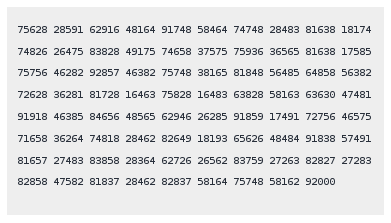
- A “challenge cipher” at the end of a 1939 book on cryptography
- The author forgot how he encrypted it (and what it meant)
- Many think that he made a mistake during encryption, hence why it has not been solved
9. Kryptos
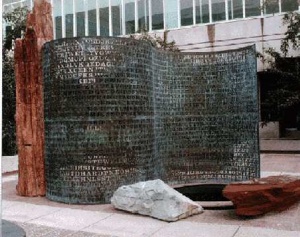
- A monument in the CIA headquarters, erected in 1990
- In 1999, the first person publically admitted to solving about 90% of it
- The other 10% remains unsolved (even by gov’t cryptographers)
8. Shugborough Hall Inscription
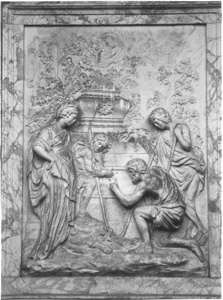
- Based (somewhat) on a painting, but with a few differences
- Has the following inscription:
- D O.U.O.S.V.A.V.V. M
- Is involved in the Holy Grail legend
7. Chinese Gold Bar Cipher

- Gold bars issued to a General Wang in 1933
- It supposedly is a deposit greater than $300 billion
- But the bank is unknown
6. Chaocipher
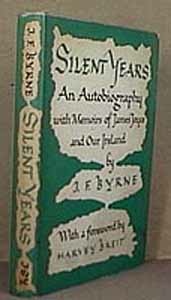
- An ‘unbreakable’ cipher from 1918
- The gov’t was rather uninterested in it
5. The Dorabella Cipher
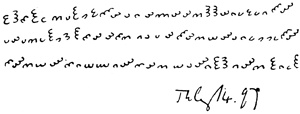
- A letter from Edward Elgar to Dora Penny in 1897 - she never figured it out, either
- 87 characters from 24 symbols
- Analysis indicates a frequency that would be expected from a substitution cipher
4. Beale Ciphers

- According to the story, a man in 1820 buried a load of treasure in VA
- One of the ciphers has been decrypted, and it details the treasure itself
- Perhaps the others lead to the treasure…
3. Linear A
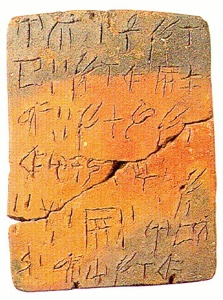
- A script used in ancient Crete
- This is from 1450 B.C.
- It is somewhat similar to Linear B, and thus some info on this tablet is understood
- But not all…
2. Voynich Manuscript

- An entire book in a secret script that is at least 400 years old
- 272 pages, although about 30 are missing
- Lists unidentified plants, as well as herbal recipies, astrological diagrams
- Has an ‘alphabet’ of 20-30 glyphs
- Written in a ‘confident’ style - perhaps a hoax
- Nobody has deciphered a single word
1. The Phaistos Disk
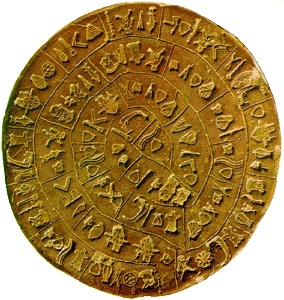
- Also from ancient Crete
- And found along with Linear A
- An inscription of hieroglyphics
- Theories: a religious hymn, a list of soldiers, or a document about the building of a palace
 -
- 